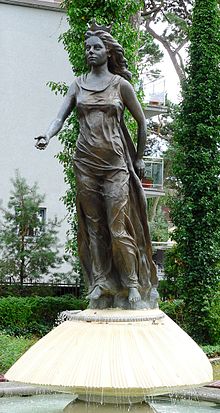Jūratė and Kastytis
Jūratė and Kastytis is a Lithuanian legend . It was first fixed in literature in 1842 by Liudvikas Adomas Jucevičius . Since then it has been adapted many times - in the form of modern poems, ballets and even rock operas.
The story
The story is very different from version to version. But the main features are the same. The goddess Jūratė ( called mermaid in some stories ), whose name is derived from the Lithuanian word jūra for sea , lived deep in the Baltic Sea in a beautiful amber castle . She ruled the sea and all of its inhabitants. A young fisherman by the name of Kastytis disturbed this peace when he caught a lot of fish. Jūratė decided to punish him and restore the peace, but fell in love with the handsome young man. They lived happily in the amber castle for a while, but Perkūnas , the god of thunder in Lithuanian mythology, learned that the immortal goddess had fallen in love with a mortal. He went wild with anger and destroyed the amber castle with a lightning bolt, leaving only millions of tiny pieces of amber. He had Jūratė chained either to the ruins or to a rock on the seabed. According to legend, this is the reason for the pieces of amber that are still washed up on the beaches of the Baltic countries after a storm.
Other versions tell that Jūratė saved Kastytis when he threatened to drown in a storm, that Kastytis was later killed by the angry Perkūnas, and that Jūratė mourns the death of her lover to this day. According to these versions, it is her tears that wash ashore hardened to pieces of amber, and that in times of storm you can still hear her crying today. Some versions specify that Kastytis came from the small fishing village of Šventoji north of Palanga .
Cultural meaning
The core of the narrative is available in variants in texts of various genres. The fairy tale Eglė, Queen of the Adders ( Lithuanian : Eglė žalčių karalienė ) as well as Jūratė and Kastytis are known . In addition to the romanticized representation, both also contain elements of Lithuanian mythology , in particular an etiological component. To date, both Eglė and Jūratė are popular female given names in Lithuania. The folklorist, ethnographer and literary historian Liudvikas Adomas Jucevičius wrote the saga about Jūratė and Kastytis and published it in Polish in Vilnius in his book Wspomnienia Zmudzi (1842).
The French anthropologist and linguist Paolo Barbaro from the École Pratique des Hautes Études in Paris sees the myth as well as other myths of Indo-European and Asian peoples (e.g. the Japanese myth of the brothers Hoori and Hoderi, hunters and fishermen) in the context of a More recent Paleolithic conception of an eternal and lonely afterlife in the then not navigable sea.
reception
literature
- The Lithuanian poet Maironis created the poem Jūratė ir Kastytis (1920) in honor of lovers. The fact that the legend is so well known today among Lithuanians of all ages is largely thanks to this ballad.
Movie
- Animated film: Amber Castle (Jantarnyj zamok) - Soviet Union 1959, directed by Alexandra Sneshko-Blotskaja
- Animated film: Jūratė and Kastytis (Jūratė ir Kastytis) - Lithuania 1989, directed by Nijole Valadkevičiūte
music
- Juozas Gruodis composed a ballet Jūratė ir Kastytis (first performed in 1933).
- The Lithuanian composer Kazimieras Viktoras Banaitis wrote the opera Jūratė ir Kastytis (first performance in Chicago - where many Lithuanians in exile live - 1972).
- Rock opera Jūratė ir Kastytis. Legendos tesinys (Jūratė and Kastytis. Continuation of the saga) by Rokas Radzevičius and Rimvydas Stankevičius (first performance on August 1, 2002 for the 750th anniversary of the city of Klaipėda with the participation of several national stars).
Visual arts
- Woodcuts from the series Jūratė ir Kastytis (1936) by Vaclovas Rataiskis-Ratas , which he created for the ballad, won prizes at an international exhibition in Paris in 1937.
- Linocut: Jūratė ir Kastytis (1977) by Vytautas Ignas.
Web links
Individual evidence
- ↑ Paolo Barbaro: Brides and grooms in the land of eternity: Urashima in Japan and Oisín in Ireland as a window over a paleolithic otherworld. In: International Association for Comparative Mythology & Traditional Cosmology Society & School of Art, University of Edinburgh: 11th International Conference on Comparative Mythology. June 2017.

